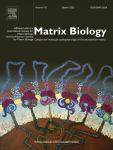Latent TGFβ complexes are transglutaminase cross-linked to fibrillin to facilitate TGFβ activation
Highlights
- •
TGFβ is regulated via the formation latent complexes in the extracellular matrix.
- •
Fibrillin-1 is a substrate for transglutaminase-2 which forms a covalent link between fibrillin-1 and latent TGFβ complexes.
- •
Formation of the cross-link increases TGFβ activation in cell-based assays.
- •
Fibrillin may direct the latent TGFβ complexes to the cell surface for activation.
- •
The structure of the cross-linked LTBP1-fibrillin complex has a perpendicular arrangement to enable bridging long-range interactions between the matrix and cell surface.
Abstract
TGFβ superfamily members are potent growth factors in the extracellular matrix with essential roles in all aspects of cellular behaviour. Latent TGFβ binding proteins (LTBPs) are co-expressed with TGFβ, essential for correct folding and secretion of the growth factor, to form large latent complexes. These large latent complexes bind extracellular proteins such as fibrillin for sequestration of TGFβ in the matrix, essential for normal tissue function, and dysregulated TGFβ signalling is a hallmark of many fibrillinopathies. Transglutaminase-2 (TG2) cross-linking of LTBPs is known to play a role in TGFβ activation but the underlying molecular mechanisms are not resolved. Here we show that fibrillin is a matrix substrate for TG2 and that TG2 cross-linked complexes can be formed between fibrillin and LTBP-1 and -3, and their latent TGFβ complexes. The structure of the fibrillin-LTBP1 complex shows that the two elongated proteins interact in a perpendicular arrangement which would allow them to form distal interactions between the matrix and the cell surface. Formation of the cross-link with fibrillin does not change the interaction between latent TGFβ and integrin αVβ6 but does increase TGFβ activation in cell-based assays. The activating effect may be due to direction of the latent complexes to the cell surface by fibrillin, as competition with heparan sulphate can ameliorate the activating effect. Together, these data support that TGFβ activation can be enhanced by covalent tethering of LTBPs to the matrix via fibrillin.

